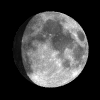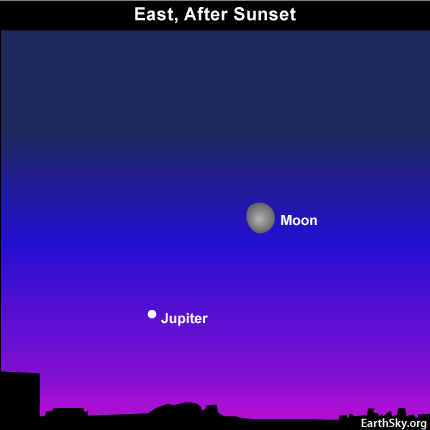Courtesy of EarthSky
A Clear Voice for Science
www.EarthSky.org

 Here is the waxing gibbous moon shortly after sunset on Monday, not real far away from the largest planet in our solar system Jupiter. The waxing moon will be closer to Jupiter on Tuesday.
Here is the waxing gibbous moon shortly after sunset on Monday, not real far away from the largest planet in our solar system Jupiter. The waxing moon will be closer to Jupiter on Tuesday.
If you are outside in twilight this evening, turn your focus on the moon. The best time to observe craters, mountains and valleys on the moon is in morning or evening twilight. That is when the moon appears bright against the darkening sky, but not so bright that its glare hurts your eyes.
If you have binoculars or a telescope, try viewing the waxing moon at evening dusk, shortly after sunset. Aim the binoculars along the terminator line, the line between the moon’s dark and light sides.
Tonight’s moon is near apogee, or farthest from Earth for this month. The moon’s distance from Earth tonight is about 252,000 miles away, in contrast to its nearest distance to Earth for this month, on October 6, of about 223,000 miles. Like all bodies in space, the moon orbits its parent body in an ellipse, not a circle. The non-circular orbit of the moon means that the moon has a closest and farthest point from Earth. When it is closest, the moon’s gravity pulls hardest on the tides.
Gary wrote, “I would expect the gravitational effect of the moon on the tides to be constant, not variable. Of course it isn’t, and why not? “ There are a couple of factors at play, Gary. The moon’s changing distance from Earth is indeed one factor. Gravity changes with the distance between two bodies in space, so when the moon is farthest from Earth for the month, its gravitational pull on our world is least.
However, that is not the primary causes of fluctuations in ocean tides. There is an even bigger factor is at play here, and that is the sun. The sun’s gravity either combines with that of the moon – or works against the moon’s gravity – to create higher or lower tides. The highest tides come at full moon or new moon, when the Earth, sun and moon are aligned in space. When that happens, the gravity of the sun and moon combine in such a way to cause the tides to swell.
The moon and Jupiter sail westward across the sky tonight, and set in the west during the wee hours between midnight and dawn.
![]() Written by Deborah Byrd
Written by Deborah Byrd
Astronomy Picture of the Day from NASA/JPL
U.S. Naval Observator Astronomical Information center
The York County Astronomical Society
 Print This Post
Print This Post








